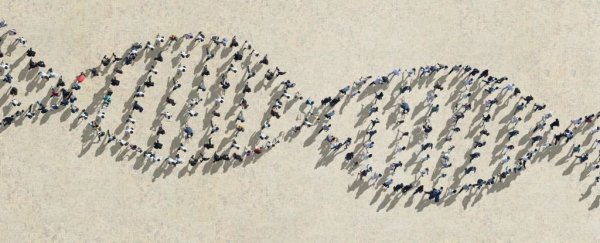Scientists have tracked a rare genetic disease that runs in a large American family in Utah all the way back to 1700s Denmark.
The dangerous genetic quirk is considered 'high-impact' because it puts people as young as 13 at risk of atrial fibrillation (AF). AF is a disease of the heart that is marked by an irregular and rapid heartbeat, and can sometimes lead to fatal blood clots or heart failure.
In the Utah family, adult individuals 18 years or older who were tested and found to carry the mutation had almost an 80 percent chance of showing signs of the disease.
Using an ancestry database and family trees to create ancestral birth location maps, researchers suspect this mutation originally came from Denmark, hitching a ride with Mormon migrants as they traveled across the Atlantic and much of the United States.
"The unique partnership between the University of Utah Health and AncestryDNA has broadened our understanding of human disease into a historical context, one that includes the history of our ancestral origins and population movement across time and continents," says genetics expert Lynn Jorde from the University of Utah.
The mutation in question is an allele called KCNQ1 R231H, and it has been previously reported in families of Northern European descent, where it seems to put people at greater risk of young-onset AF.
While some forms of young-onset AF are not hereditary, health records in Utah found at least five 'apparently' unrelated families where it was.
A 13-year-old with paroxysmal AF, for instance, was found to have a mother with a history of cardiac arrest, as well as a maternal aunt that died in her sleep in her early 20s.
In all five families with inherited young-onset AF, genetic sequencing found the KCNQ1 R231 allele was responsible.
"Looking forward, our results also provide a glimpse of how large ancestry databases can be used to better understand the geographic distributions of persons at risk for particular genetic diseases, a necessary prelude to precision health care outreach activities," the authors write.
One family in Utah that held the KCNQ1 R231H allele agreed to have their genetic mutation assessed further. In this family, five AF-risk allele carriers consented to having their DNA submitted to the AncestryDNA database.
In the end, researchers found genetic matches for all five individuals in the database, and 824 individuals seemed to share their same genetic quirk.
Creating an algorithm to track these chromosomes over time and space, researchers created a possible timeline for the family's mutation.
The young-onset AF gene seems to come from their ancestors in Denmark way back in the 1700s. From 1800 to 1850, these ancestors then migrated to the Eastern United States, and by the 1900s, they had arrived in Utah.
That isn't the whole picture, however. Whole-genome sequencing suggests the KCNQ1 R231H allele goes back 5,000 years, plaguing some 200 generations. But our genetic databases and family timelines don't go back that far.
Nevertheless, 300 years is still an impressive timeline, long enough for researchers to help identify people in the US today who might be at risk of young-onset AF because of their genes.
"Any genetic variant that imparts risk of a potentially lethal, yet treatable, condition provides abundant motivation for the development of methods to identify at-risk individuals," the authors conclude.
"Here, we offer an example of such a method in characterization of the KCNQ1 R231H mutation and identification of carriers thereof. While portions of our method are unique to the resources of AncestryDNA, much of it can be applied to any large genotype database."
The study was published in Nature Communications.
